kdmz: Benefit from Automated Product Recommendations
With business software the kdmz (Kantonale Drucksachen- und Materialzentrale Zürich) wants to offer its customers an optimal benefit and to support its staff in their processes efficiently. Four years ago kdmz has, therefore endeavored to inte-grate new functions in its business software. In 2002 functions like customized product ranges, the mapping of procurement hierarchies and processes as well as various self-service functions were implemented in the online shop [Knechtli 2003]. In 2008 the business software OpaccOne was extended by product recom-mendations which are automatically computed and personalized. This case study describes the procedure during the development and introduction of the product recommendations and how they are used in the daily routine.
1. The Company
The kdmz was founded in 1903 and since January 1st, 1997 it has been an office of the finance administration of the Canton of Zurich. kdmz carries out cross-section and mediatory functions and it is the central procurement and service office for the cantonal administration. This includes organizations and institutions that are spon-sored by the public hand or where the canton has an involvement (e.g. the Univer-sity Hospital Zurich). kdmz can be called a procurement service provider for these organizations [Tanner/Wölfle 2002].
The efficient and effective supply of the public administration with indirect goods at cost-covering prices stands in the centre of the business activity. In the year 2007 the company achieved a turnover of about 45 million CHF with 54 regular and 8 protected jobs.
Business enterprises and private households can obtain printing products like legal texts, official forms and other publications of the canton from kdmz.
Background, Industrial Sector, Products and Target Groups
The product range covers four areas: Supplies (office material and cleaning agents), printing products (forms, publications, means of communication), capital goods (IT equipment, photocopier etc.) and services (IT and management consul-tancy).Approx. 1'500 official forms and pamphlets (publications of the canton) as well as 3'500 office material and cleaning articles are included in this assortment. kdmz operates production centers of its own as a core competence. This includes a modern digital print center for brochures, books and photocopying, and a center for desktop, printing and confectioning works. Increasingly, additional services are offered to the customers as well like consulting, storage, dispatching services up to and including collection, disposal of special products as well as courier services.
In the year 2007, approx. 98'000 orders with about 5'400 customers from the public administration of the canton and approx. 50'000 customers from business enter-prises and the private households were processed. 45'000 of the 98'000 orders were submitted via e-shop.
The fulfillment for the customers in the public administrations is carried out di-rectly by kdmz. It delivers the goods directly on its daily tours. Exceptions are only made with very large quantities which kdmz cannot deliver with its own vehicles. As a rule, business customers and private households are supplied by postal ser-vice.
Corporate Vision
kdmz puts the customer satisfaction and customer benefit into the center of its business activity and therefore kdmz adapts the entire company structure to new market requirements permanently and consistently.
Stellenwert von Informatik und E-Business
In the context of its e-government strategy, the Canton of Zurich wants to offer different administration services on the Internet. To operate and to continuously develop further e-procurement solutions is a central task of kdmz. With the e-shop, kdmz provides a single point of contact for the procurement offices of the public administrations.
kdmz is active in the e-business and in the e-government areas on cantonal and federal level: e.g. kdmz offers electronic forms for official services of Zurich mu-nicipalities. kdmz is one of the first registration authorities in Switzerland for qualified digital signatures. Moreover, kdmz is the service center for the platform publicjobs.ch. publicjobs.ch enables the administrations of the federation, cantons and municipalities to publish their job offers on a joint platform. Job-seekers are able to inform themselves over a portal about all vacancies in the public sector. Furthermore kdmz is the office of the organization simap.ch which operates an information system about public procurement in Switzerland.
2. The Trigger of the Project
Initial Position and Impulse for the Project
Already in 1998 kdmz laid the foundation for an efficient platform for the pro-curement of office materials and office systems with the implementation of an e-shop. The services that kdmz provides its customers via e-business were extended continuously since then.
In order to use its customer data better, kdmz participated as an economy partner in the research project PersECA (Personalization of E-Commerce Applications) of the Competence Center E-Business Basel at the University of Applied Sciences Northwestern Switzerland FHNW. Based on existing customer profiles and data, new functions for personalization should be identified, developed and integrated. With these functions kdmz aimed primarily at generating additional benefit for the customers and further promoting the e-shop as distribution channel.
Introduction of the Business Partners
In the described project kdmz was supported by the following partners:
IT Partner
Opacc is a software developer and IT full-service supplier for business automation. Opacc has offered comprehensive computer solutions for sale, enterprise resource planning, purchase, service and after-sales service for more than 20 years. Small and medium-sized companies in the sectors trade and service are its main custom-ers. At kdmz, the business software OpaccOne is used for the handling of all busi-ness processes in the trade, in the administrative area of the digital printer center and for the e-shop. OpaccOne and its precursors have already been in use at kdmz since 1998.
Concept Partner
The Competence Center E-Business Basel (CCEB) at the Institute for Information Systems at the University of Applied Sciences Northwestern Switzerland FHNW has worked on conception and management for cross-organizational use of infor-mation and communication technologies in value-adding areas since 1999. The CCEB brought its knowledge about personalization into the project and led it me-thodically in the analysis phase.
The Information Systems Research Group of the Department of Informatics of the University Fribourg has been engaged for many years with the use of new tech-nologies in e-commerce, such as recommender systems. The Information Systems Research Group participated in the selection of the procedures used to compute the product similarities.
3. Additional Benefit from Recommendations
Product recommendations can already be found in different e-shops in the B2B and B2C e-commerce. These recommendations are often displayed in the detail view of a product under the heading "Customers Who Bought This Item Also Bought". Such recommendations can be generated in two ways: They were either entered into the e-shop manually or were computed automatically with existing data. A combination is just as conceivable because depending on the company’s interest, recommendations computed automatically could be of limited use. A manual cor-rection makes sense if, for example, a product that appears prominently in the computed recommendations is going to be taken out of the product range.
In addition, personal product recommendations can only be given to customers whose needs are well known. If a company has many customers this is not possible with justifiable effort. To solve these difficulties, kdmz has integrated automati-cally computed personalized recommendations into their applications.
Within the last few years, different procedures with which recommendations can be calculated based on existing data were developed. The procedures at kdmz use transaction data (invoice and credit note positions) for the calculation of personal-ized recommendations. In the following chapters these procedures are explained in the context of the business view, the process view, the application view and the technical view.
Business View and Objectives
With the recommendations introduced in its business software kdmz wants to gen-erate an additional benefit for all customers. Furthermore, the customers from the administration of the Canton of Zurich shall be persuaded to adopt a core product range defined by the canton (cf. Figure ?1).
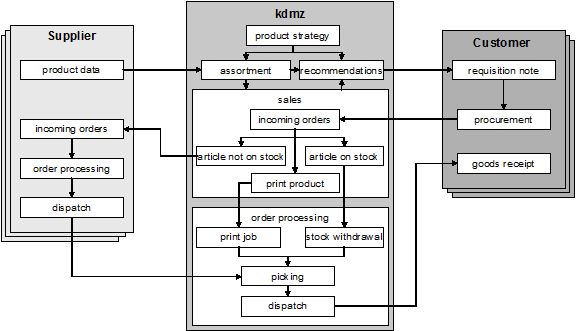
Figure 1: Business Scenario for kdmz
The public administration of Zurich optimizes their product range in the context of the project "E-Procurement". About 2’800 office material articles shall be reduced to a core product range of roughly 1’300 articles. This is made primarily to lower costs by slimmer processes and larger purchasing quantities. The offices which have purchased products outside the newly defined core assortment till now shall get appropriate products of the core product range.
All other public companies and institutions in the canton are not affected by this optimization of the assortment. Furthermore, they can order products from the complete assortment. Unlike the public administration they are not obliged to pur-chase from the kdmz.
Process View
Before recommendations can be displayed in the e-shop, they must be computed by the system. In the process view the calculation and the use of recommendations are regarded as separate processes.
In principle, the automated calculation of product recommendations is based on existing data. The recommendations are computed in one or several steps, accord-ing the mathematical algorithm is used. Depending on the kind of available data different formulae are suitable. The following always applies: The more data are available for calculation the more exact the recommendations become.
The most reliable recommendations are provided by formulae which are based on product ratings as they can be entered by customers on many e-shops: The ratings of the single customers are mathematically compared with each other. The results are product or customer similarities on which the recommendations can be based. The similarities are expressed with numerical values: e.g. with values between 0 (weak) and 1 (strong). A similarity of against 1 would mean that the two compared products are almost identical in their ratings by the customers. If a value is NULL, the value for the similarity is empty.
If ratings are not available, the completed purchases (transactions) can also be considered as rating appraisals. It is assumed that the customers like an article they have purchased if they do not return it after the purchase. Procedures which are based on such ratings are called "Collaborative Filtering" procedures [Pep-pers/Rogers 1997, p. 246].
Since no ratings can be given for the products in the e-shop of the kdmz, the trans-action data from the sales are used for the calculation of the recommendations. For these calculations kdmz uses the procedure of Deshpande and Karypis [2004]. The procedure supplies the product similarities between two products in the first calcu-lation step and personalized recommendations in the second step.
Once a month, the sales data (invoice and credit note positions) and product data are queried from OpaccOne for the first calculation step (cf. Figure ?2). Each time the sales data contain all of the orders of about four years – the current year plus the last three years. From approximately 400'000 data records with an extent of roughly 4'500 products about 20 million similarities are computed.
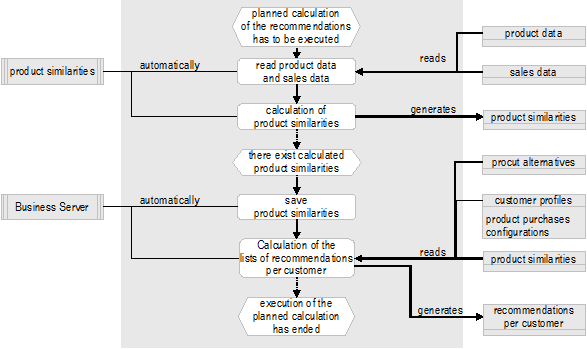
Figure 2: Calculation process for recommendations
These product similarities are stored in the OpaccOne Business Server for the sec-ond calculation step. The similarities would already be suitable to express general, non-personalized recommendations. In the e-shop, for example, an anonymous guest can see similar products as a recommendation in the detail view of a product.
In the second calculation step the product similarities are used to prepare automati-cally a personal list for defined customers with the 50 best product recommenda-tions. These lists are generated by stored queries and routines.

Figure 3: Example for the calculation of personal recommendations
Per product the similarities to the products already purchased by the customer are added. Figure ?3 shows an example: We assume that a customer has purchased the products i, j and k, but not the products x, y and z. The added similarities yield to the ranking of the recommendations for the customer. The product with the highest value represents the best recommendation. In this example it is product y.
When personalized lists of products are built the deposited customer product range is taken into account or the products are replaced with alternatives from the core assortment (cf. chapter ?3), depending on the configuration in the customer profile . Now the recommendations can be used in the sales talk with the customer, e. g. on the telephone and for the advertisement in the e-shop (cf. Figure ?4).
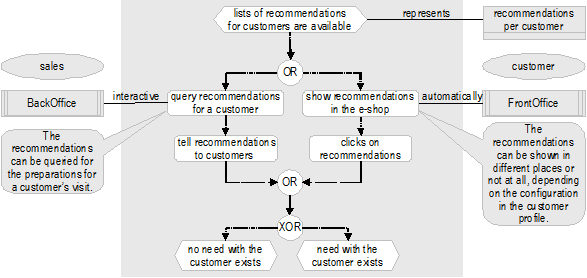
Figure 4: Use of the recommendation
Application View
OpaccOne has a layered software architecture and is designed according to the concept of a service oriented architecture (SOA) [Service Oriented Architecture] (cf. Figure ?5). For all applica-tions the "Business Server" is central. It provides data as business objects and fun-damental functions as business services to further integrated applications. The most important further applications are divided up into the parts of BackOffice and FrontOffice.
The BackOffice applications support internal users with common ERP functions. At kdmz these are the applications "Sale", "Enterprise Resource Planning", and "Management Information System". The FrontOffice applications are used for the interaction with customers. In use is the application "WebSales" which is based on the OpaccOne "Web Portal". It offers the customers a variety of self service func-tions besides the common e-shop functionalities.
For some important customers kdmz supports entire procurement processes. For this purpose the B2B e-shop contains extended functions, for example, for manag-ing the purchasing employees and their procurement budgets by an administrator of the customer or for releasing orders by supervisors.
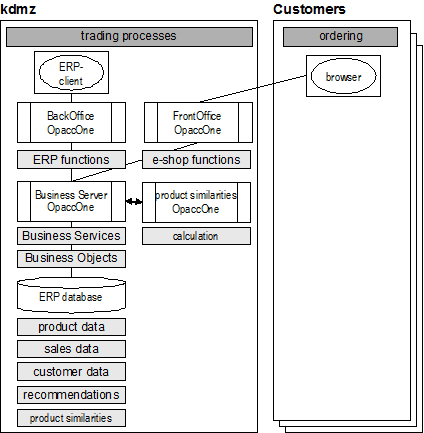
Figure 5: OpaccOne: Business Server with integrated applications
The self-service functions in the e-shop enable the customer to decide himself whether recommendations are shown to him or not. Per default, recommendations are activated for all customers. With the help of the customer profile in the Back-Office applications it can be further personalized where in the e-shop the recom-mendations should be displayed: Everywhere in the product catalog, only in the detail view of an item, only in the shopping basket or in all mentioned places. It is activated as default for all customers that recommendations are shown in all men-tioned places.
The calculation of the product similarities is an application which is based on the Business Server. After an initial configuration the application runs fully automati-cally without any further user interactions.
Technical View
For the automatic calculation of the recommendations investments in new hard-ware were not necessary. The application "Product Similarity" could be installed on a virtual computer on the existing systems. The technical view, therefore, de-scribes the existing hardware and software environments at kdmz (cf. Figure ?6).
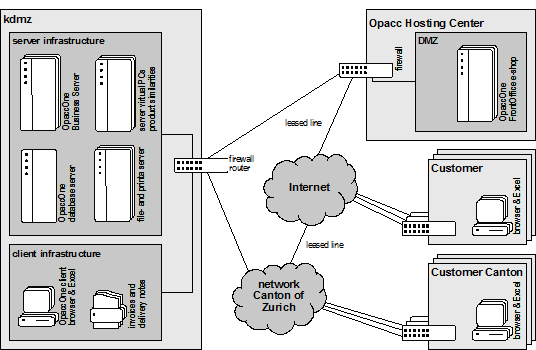
Figure 6: Technical view of the kdmz systems with the Opacc Hosting Center
The largest part of the systems is operated by kdmz in-house. The systems for the FrontOffice applications are outsourced to the Opacc Hosting Center in Kriens. The FrontOffice applications are connected to the systems of kdmz over a leased line. The access to the e-shop by staff and customers is carried out via the Internet. The customers in the public administration access the e-shop via the network of the Canton of Zurich and the Internet.
Central systems like the Business Server run on redundant servers. Microsoft oper-ating systems are in use on all systems according to the purpose. Windows Server 2003 is installed on servers and Windows XP Professional on clients. Batch jobs, background jobs and smaller applications are primarily executed on 12 virtual computers. Resources like CPU performance or memory can be assigned dynami-cally to each oft the virtual computers as required.
4. Project and Operations
In the context of the FHNW research project PersECA the first workshops for creating ideas took place in spring 2007. The objective of these workshops was to find and to draw up new functions for the personalized customer dialog. Supported by the university, selected staff members of kdmz identified 36 optional functions. Based on the results of a value analysis, ten of them were followed up and worked out in detail. The solution introduced in this case study is based on three of these functions:
- To provide personalized recommendations for the customer.
- To support the streamlining of the core assortment with the help of recommen-dations.
- To be able to look at the personalized recommendations for the preparation of sales talks.
Investment Decision
The decision was favored by the fact that the research project of the FHNW was sponsored by the Swiss KTI/CTI (Commission for Technology and Innovation) at the Swiss Federal Office for Professional Education and Technology: Except for CHF 10'000 the performance of the university partners was paid by the KTI/CTI. The performance of the staff of kdmz and Opacc was not supported by the CTI.
A classical investment decision that considers the return of investment was not taken. But as mentioned, for the functions worked out a benefit analysis was con-ducted during the project.
Project Management and Change Management
During the phases of creating ideas and analyzing the initial situation the project was planned and arranged by the universities. In the realization phase the lead of the project went over to the business partners. In this phase the university staff members acted as consultants. Their knowledge was primarily in demand at the selection and implementation of the suitable procedures for the calculation of the personalized recommendations. Opacc elaborated the detail concept for the func-tions in cooperation with kdmz and carried out the technical implementation after-wards.
Development and Roll-out of the Software Solution
Before the software for the calculation of the product similarities was imple-mented, it was tested with four different collaborative filtering processes if the transaction data were suitable. Depending on the procedure, particular factors have more or less influence on the quality of the recommendations. Factors are e.g. the number of purchases or the ratings of a product, the number of customers, who have rated or purchased a product, or the number of the different products and customers.
The quality was measured with 500 to 1'000 randomly selected purchases which were removed from transaction data before the calculation of the similarities was made. The idea is that a good procedure should compute product recommendations that represent the removed purchases. The higher the hit rate of recommendations on removed purchases is, the better is the procedure. Quality measuring was car-ried out approximately ten times per procedure. Apart from the suitability of the procedures it was examined which period of transaction data provides good rec-ommendations: Four years back turned out for kdmz to be ideal.
A bigger effort was required for the roll-out for the handling of customer profiles and product data. The customer profiles had to be adjusted at the beginning, con-sidering whether recommendations may be shown or not. Some customers could only order from a restricted assortment at this time. Custom-designed products and accessories to certain products (e.g. toner for laser printers) should not appear in the recommendations. In particular, it should be avoided that accessories are rec-ommended to equipment which they do not fit. Such products were blocked for the use as recommendations.
Regular Maintenance
Due to the experiences with this roll-out, the processes were extended for the entry of new customers and new products. When entering a new product, for example. it has to be decided whether the product shall be blocked for recommendations or not. Accordingly, it has to be specified for every new customer whether she/he shall receive recommendations or not.
For the project "E-Procurement" (cf. chapter ?1.3.1) alternative products are entered manually to all existing and new products, which are no longer part of the core product range. This classification was already made for a part of the products.
The calculation of the product similarities themselves takes place automatically. Apart from the usual operating controls by the system administrators, the applica-tion does not need any maintenance.
5. Experience
User Acceptance
kdmz staff members were included in the discussion of the subjective assessment of the quality of the computed recommendations. It was noticed that custom-designed products like forms and envelopes turn up as recommendations. These products were blocked for the use as a recommendation.
After an initially skeptical attitude of the staff members towards recommendations the experiences are positive today. The staff is convinced of the quality and the benefit of the recommendations.
Objective Attainment and Caused Changes
The first experience with automatically computed recommendations indicates that the objectives mentioned in chapter ?3 and the expectations were achieved. An obvious benefit emerges in the preparation of sales talks because recommendations provide new aspects of a customer.
Indicators
For the quality measurement of the recommendations [quality of recommendations], e.g. it is evaluated how often customers have clicked on shown recommendations. Further it is evaluated how often customers opted out the option "Show recommendations" in the self service functions of the e-shop. Since in July 2008 the first solution has gone into opera-tion, the following indicators have emerged:
- Click rate to " shown recommendations in the product catalog": 0.59%
- Purchase rate to "shown recommendations in the shopping basket": 1.60%
- Number of customers who want to see no more recommendations: 0
These values are high in comparison with the click rates of 0.18% on advertising on the Internet in Europe [ADTECH 2007]. The quality of the recommendations is therefore good. Since no customer has opted out of recommendations, they are apparently no nuisance to the customers.
6. Success Factors
As mentioned in chapter ?2, the Opacc business software has been in use at kdmz since 1998. With the requirement to tie to the procurement processes of the customers, high requirements arise for the business software. Therefore new ways had to be followed and new software functions had to be developed by kdmz. kdmz belongs to the selected Opacc customers who are looked after directly by a special "innovation team". The automatically computed recommendations are such an innovation which was developed for kdmz and taken into operation by Opacc..
Specialties of the Solution
With recommendations that are based on ratings or transaction data, there is a so-called “cold start” problem: Personalized recommendations cannot be computed for new customers who have never purchased anything yet. kdmz solved this prob-lem with a manually prepared list of recommendations. These represent the shop-ping basket of an average customer.
With OpaccOne's layered and open architecture the integration of new applications like the computation of the product similarities is simple to realize.
Reflection of the Competitive Advantages
A competitive advantage results from the fact that automated recommender sys-tems are still rarely to be found in the business software of Swiss SMEs. The com-petitors of kdmz are not using any recommender systems yet.
Replacing computed recommendations by alternatives opens up another competi-tive advantage. Replacing can be used for customers who are not subject to the procurement rules of the canton. These customers can be acquainted with new products or products that kdmz wants to promote.
Lessons Learned
There is a difference of attitude of those involved in a research project depending on whether they are from the economy or university. The economy partners pri-marily see the benefit for the company and the customers. The universities want to explore whether theoretical methods are suitable for the use in an economic envi-ronment. This mixture provides a large profit and extends the horizon of all par-ticipants.
The results of a research project are not seize able at the beginning. The partici-pants do not know yet how the concrete result will look like. Furthermore, the expectations are different as described above. For these reasons a research project is often subordinated to other activities in the market orientated environment.
References
ADTECH AG (2007) ADTECH-Studie belegt fallende Klickraten in der Online-Werbung: http://de.adtech.info/archiv2007_1/pr-07-05-10_de.htm.
Deshpande, Mukund; Karypis, George (2004): Item-based top-N Recommendation Algorithms: ACM Transactions on Information Systems, 22 Issue 1, S. 143–177, New York: ACM Press, 2004.
Knechtli, Hanspeter (2003):Fallstudie Kantonale Drucksachen- und Materialzentrale Zürich (kdmz), in: Schubert, Petra; Wölfle, Ralf; Dettling, Walter (Hrsg.): E-Business Integration – Fallstudien zur Optimierung elektronischer Geschäftsprozesse, München, Wien: Hanser Verlag, 2003, S. 53-66.
Peppers, Don; Rogers, Martha (1997): Enterprise One to One: Tools for Competing in the Interactive Age, New York: Bantam Doubleday Dell, 1997.
Tanner, Christian; Wölfle, Ralf (2002): E-Procurement: Entwicklung von Grundlagen für einen Entscheidungsleitfaden, Basel: Fachhochschule beider Basel (FHBB), Institut für angewandte Betriebsökonomie (IAB), Arbeitsbericht E-Business Nr. 8, 2002.



